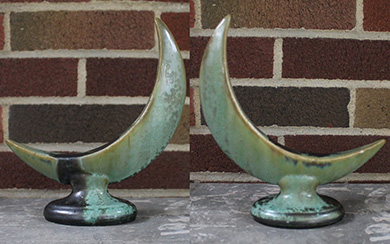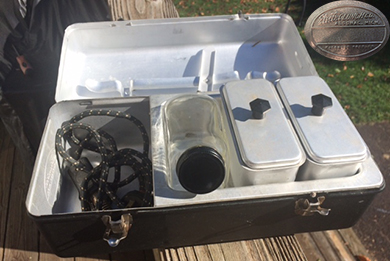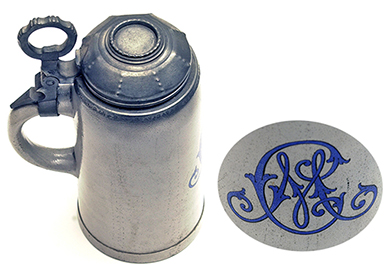 |
|
|||
 |
 |
|||
Copyright © Harry Rinker, LLC 2017 Questions
and Answers
QUESTION: I collect arts and crafts pottery. At a recent auction, I bought a box lot of miscellaneous kitchenware for $8.00. A Fulper 9-inch high, crescent moon vase was among the items in the box. I assume it is a vase. There is a rectangular hole cut in the center of the interior of the moon. Attached to the back is a paper label that reads: “Panama-Pacific Exposition San Francisco 1915, Highest Award to Fulper Pottery.” The label is deteriorated and hard to read. My crescent moon vase has a 1-inch streak of dark glaze, matching the glaze on the base rim, running down the side of the vase into the pedestal and ending on the rim. The vase can be displayed so this is hidden. Is this a defect? Was this piece exhibited at the Exposition? What is its value? – BM, Kent, Ohio, Email Question 
ANSWER: In 1814, Samuel Hill established a utilitarian pottery company in New Brunswick, New Jersey. The company made earthenware drainage pipes and pots. When Samuel Hill died in 1858, Abram Fulper purchased the firm. Changing the name to Fulper Pottery, Fulper made an assortment of stoneware products. Abram Fulper’s sons continued the company, making products under the brand “Fulper Bros.” or “Fulper Bros. & Co.” In 1899, William Hill Fulper incorporated the company as the Fulper Pottery Company. The company made fire-proof cookware and storage Jars. The Gem-Proof Filter, a water cooler, was one of its most successful products. William H. Fulper II was instrumental in introducing art pottery at Fulper. Around 1900, master potter John Kunsman produced hand thrown jugs and vases with a solid color glaze. Pieces were exhibited at the 1904 Louisiana Purchase Exposition. Fascinated by Chinese glazes and shapes, William Fulper was determined to reproduce them. He enlisted the help of Dr. Cullen Parmell of Rutgers University. Many of the glazes developed by Parmell were difficult to mass produce. In 1910, Martin Stangl joined Fulper and developed a line of Vasekraft glazes and shapes, which included lamps. Fulper collectors date Fulper Art Pottery from this period. Fulper won a gold medal at the 1915 Panama-Pacific International Exposition in San Francisco. Pieces made after 1910 were molded. Because Fulper experimented with a wide variety of glazes, dozens of glazes were used on the same mold. Pieces produced in the 1920s tend to be of higher quality due to less production pressures. After World War I, Fulper Art Pottery shifted toward English and Spanish Revival styles. In the 1920s and 1930s, Fulper Art Pottery changed focus again by creating designs and glazes that appealed to Art Deco, classical, and primitive tastes. Production of Fulper Art pottery ceased in 1935. [For additional details, see http://stanglpottery.org/welcomefulper.htm] Your crescent moon vase was not exhibited at the 1915 Panama-Pacific Exposition. Fulper used the label on its pieces to capitalize on its winning the gold medal. The label is important because it dates the production of your piece as post-1915. Based upon a photograph of Lot #30 of an October 26, 2013 Rago Arts auction, the crescent moon vase came in two sizes, one of which was shape 666. Your example has a crystalline green glaze. The black streak on the back is deliberate. Glazers were given a great deal of latitude when glazing a piece. The secondary market retail value for your Fulper crescent moon vase is between $150.00 and $200.00 – not bad for an $8.00 box lot find. QUESTION: I recently purchased a metal Electrolunch box made by the Electrolunch Co. of Algonac, Michigan. The inside has four sections -- two with a metal container, one with an oval glass jar with a metal cap, and one empty. There is a cord in the empty section. There appears to be a device on the lid to use to wrap the cord around; hence, the fourth section was most likely empty. What can you tell me about the piece? – BW, North Coventry, PA, Email Question 
ANSWER: Algonac, Michigan, is best known as the former home of the Chris-Craft boat company. I was not able to find specific information about the company that made Electrolunch on the Internet. I recommend you call the Algonac-Clay Library [(810) 794-4471] and ask the reference librarian if any specific information exists. Your lunch box is made of aluminum and came in three colors—metallic gray, red, and yellow. It measures 12-inches by six-inches by six-inches. It was made in the late 1940s or early 1950s. An article in the June 22, 1949 edition of the Port Huron, Michigan, “Times Herald” mentions the Electrolunch box. Value for a complete Electrolunch box in working order is between $25.00 and $35.00, far too low for an object as neat as this. It is a great conversation piece. Having never given much thought about electric lunch boxes, I decided to see if similar products are available in today’s marketplace. The answer is sort of. Amazon.com offers a number of choices. HotLogic Mini Personal Oven is close but deserves no cigar. The RoadPro 12-volt Portable Stove is closer but only contains a single tray. The Luckstar Electric-Heading Lunch Box does have a three-compartment stainless steel removable tray. The cost for these items equals or exceeds the value for a secondary market working example of the Electrolunch box. The Electrolunch box stands alone in its ability to tote cold items and food needing to be reheated. An opportunity awaits some enterprising manufacturer to steal a great idea from the past. QUESTION: I purchased a chocolate set at a garage sale for an over eighty-year old relative. The set has an Oriental motif. The pot has a tapered body with a tree-like arm and spout. The sugar is covered. The sugar and creamer have a glazed pink interior. Pieces have a cobalt blue ground on which is found a green foliate border motif and a central design of a white stork standing in a pond featuring lily pads with red flowers. The pieces are not marked. My relative had a large collection of majolica pieces. Is this one of the pieces? What is my chocolate set’s value? – MF, Steubenville, OH, Letter with photographs ANSWER: Majolica has many meanings. First, Majolica is used to define earthenware (clay) that is covered by a glossy, opaque tin glaze. Manufacturers used it to imitate Italian wares. Second, it specifically describes 19th and early 20th century earthenware featuring naturalistic shapes and designs in bright colors with a glossy finish. The second does not apply in your case. The glaze on your pieces is meant to resemble a Majolica glaze but claiming it as such is a reach. It is high gloss but likely achieved using a different method. You do not own a chocolate set. The clue is the handle on the pot. Pouring spouts on chocolate sets are located near the top of a pot. You own a Japanese tea set made in the 1920s or early 1930s and meant for export to the United States. The value of the tea set is between $30.00 and $40.00. Such sets are difficult to sell. The secondary market is flooded with examples. Young people no longer have the time or inclination to use tea sets for entertaining. Their liquids of choice come in bottles. QUESTION: I have an earthenware stein that my father brought back from Germany following World War II. He was a Staff Sergeant and chef in the 10th Armored Division. The stoneware stein stands 9 1/4-inch high from the base to the top of the lid ring. The diameter at the base is about 4 1/8-inches. There are two small 1/8-inch “F” notations, one above the other on the base. There is a monogram on the front. My best guess is an intertwined script “A” and “C” across a capital “C.” Any ideas what I’ve got? – CM, Reading, PA, Email Question 
ANSWER: You have an early 20th century stoneware stein. The workmanship of the handle design and stamped design on the metal rim of the lid confirm the date. Although I was not able to identify the manufacturer, the good news is that your stein is not a tourist stein. I also was not able to identify the monogram. Two possibilities exist. The first is the initials of the owner. The second is a brewery’s or other manufacturer’s logo. The empty circle on the lid suggests there once was a porcelain or metal insert. It is missing. The stein’s age saves it. In its present condition and given how little is known about it, it has a secondary market value between $35.00 and $50.00. Harry L. Rinker welcomes questions from readers about
collectibles, those mass-produced items from the twentieth and twenty-first centuries.
Selected letters will be answered in this column.
Harry cannot provide personal answers.
Photos and other material submitted cannot be
returned.
Send your questions to: Rinker on Collectibles, 5955 Mill
Point Court SE, Kentwood, MI 49512.
You also can e-mail your questions to
harrylrinker@aol.com.
Only e-mails containing a full name and mailing address
will be considered.
You can listen
and participate in
WHATCHA GOT?, Harry’s
antiques and collectibles radio call-in show, on Sunday mornings between 8:00 AM
and 10:00 AM Eastern Time.
If you
cannot find it on a station in your area,
WHATCHA GOT?
streams live on the Internet at www.gcnlive.com.
SELL, KEEP OR TOSS?: HOW TO DOWNSIZE A HOME,
SETTLE AN ESTATE, AND APPRAISE PERSONAL PROPERTY
(House of Collectibles, an imprint of Random House Information Group, $17.99),
Harry’s latest book, is available at your favorite bookstore and via
www.harryrinker.com.
|
||||